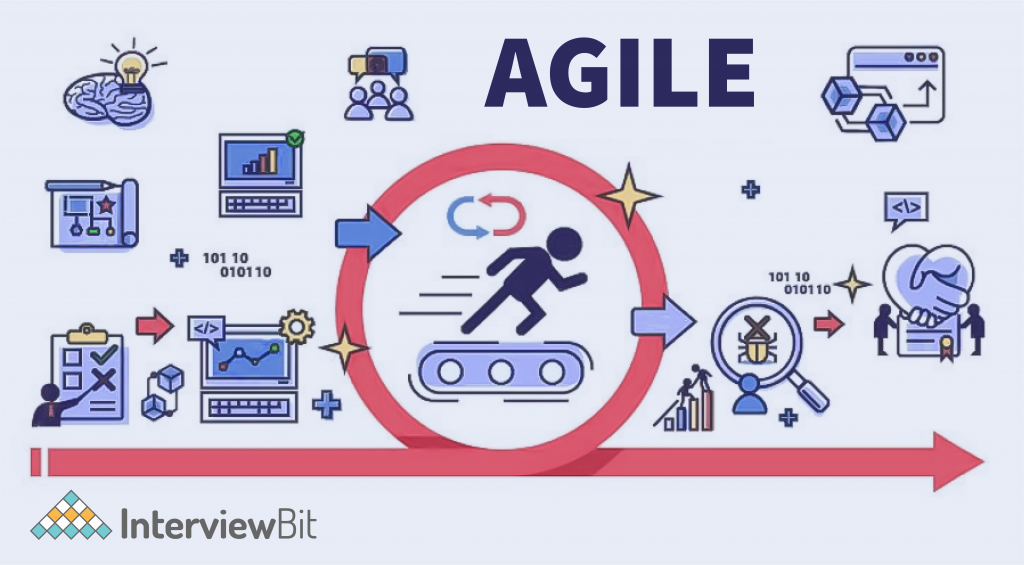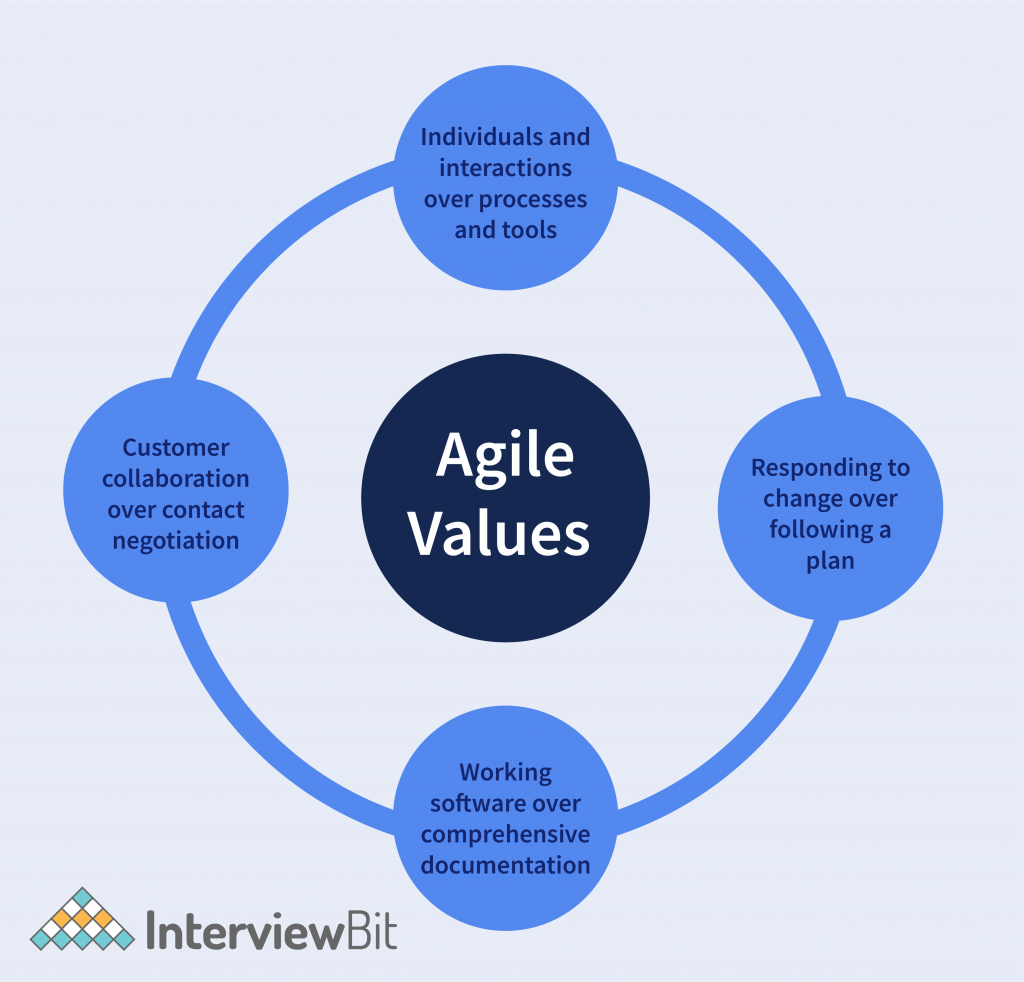- Introduction
- Advantages of Agile
- Four Agile Values
- “Individuals and Interactions Over Processes and Tools”
- “Working Software Over Comprehensive Documentation”
- “Customer Collaboration Over Contract Negotiation”
- “Responding to Change Over Following a Plan”
- 12 Agile Principles
- 1. Early and continuous delivery of valuable software
- 2. Embrace Change
- 3. Frequent Delivery
- 4. Cooperation
- 5. Autonomy and motivation
- 6. Better communication
- 7. Working software
- 8. Stable work environments
- 9. Technical excellence and Good design
- 10. Simplicity
- 11. Self-organizing teams
- 12. Reflection and adjustment
- Conclusion
- FAQs
Introduction
Thirty years back, people lacked an understanding of information technology or automation. With the invention of the computer, the world started transforming rapidly. Taking into consideration the latest events, we have witnessed several changes, like, floppy disks to cloud storage, from a room full of computing machines to smartphones. All these improvements wouldn’t be achievable without innovation and technology.
Talking about technology, every day, new technology is invented. Technology is not just associated with Information technology, it is relevant to business, government, hospitals, etc. Technology and software development go hand in hand. To be precise, software development is an essential component of technology. The software development process suggests dividing the software development work into various phases to enhance the design, project management, and product management. Another term related to software development is the software development life cycle. The software development life cycle, also known as SDLC, describes a process that encloses planning, developing, testing, and deploying software.

Software development has been revolutionized by Agile. Currently, agile principles underpin all agile development approaches and techniques. If these principles are applied accurately, the 12 agile principles assist to overcome several problems encountered on traditional projects like late delivery and quality problems. Agile is based on 4 fundamental values and 12 essential principles. While the agile values offer project managers and programmers a very general synopsis of what it implies to be ‘agile,’ and guide them through the agile process, the 12 agile principles provide instances of how agile should be enforced. The 12 agile principles underpin every thriving agile project and can enlighten even non-agile teams. They form an important element of any agile project management course.
Confused about your next job?
Advantages of Agile
- One of the major advantages of incorporating the agile manifesto into product development is gaining more elevated product quality. Routine testing becomes a more significant part of the cycle, and products will be going through regular checks to recognize issues. Thus, any changes which ought to be made can be addressed along the way.
- As development is divided into smaller sections throughout a development lifecycle, teams can draw their focus on attaining specific goals within a fixed timeframe instead of tackling the whole product in one. Sprint retrospectives let teams comprehend where previous sprints may have gone bad and what they can do to enhance upcoming ones.
- Another advantage is adopting flexibility and adaptability. Product teams offer products to customers sooner and integrate feedback into future releases. Thus, products may be modified and enhanced over time as programmers react to customer experiences.
- With these improvements, the possibility of projects being successful can be continuously increased. The risk of failure overall is less, and the expense of modifying products on a small and big scale may be lowered. It’s not the same as deferring a release or inducing customer frustration as huge changes are undertaken in bulk.
- Agile principles allow teams to have tighter control over their projects. Team members are aware of what to do in each sprint, while the greater focus on cooperation and communication diminishes the risk of errors or oversights. Utilizing automated software simplifies processes and reduces the time spent on avoidable manual tasks, too.
- Ultimately, embracing agile principles in product development can attain valuable ROI quicker than traditional models. This is owing to shorter development cycles, greater knowledge of user experiences, and taking steps to fix issues post-release.
Four Agile Values
The Agile Manifesto includes four foundational values and twelve supporting principles which direct the Agile approach to software development. Each Agile methodology uses the four values in various ways, but all of them depend on them to drive the development and delivery of high-quality, functional software.

“Individuals and Interactions Over Processes and Tools”
Valuing people more highly than tools or processes is easy to comprehend as it is the people who react to business requirements and push the development process. If the development is driven by process or tools, the team is less likely to welcome change and less likely to fulfill client needs. Communication is an instance of the difference between valuing process versus individuals. In the case of individuals, communication is fluid and occurs when the need emerges. But in the case of process, communication is organized and needs specific content.
“Working Software Over Comprehensive Documentation”
Historically, a huge amount of time was wasted on writing the product for development and ultimate delivery. Technical specifications, requirements, prospectus, documentation plans, test plans, interface design documents, and approvals are needed for each. The list was comprehensive and was a reason for the long holds in development. Agile does not put an end to documentation, but it simplifies it in a form that provides the programmer with what is required to do the work without getting worked up about minutiae. Agile documents need as customer stories, which are sufficient for a software programmer to start the task of creating a new function.
The Agile Manifesto prefers working software more than documentation.
“Customer Collaboration Over Contract Negotiation”
Negotiation is the period when the product manager and the client chalk out the details of delivery, with points throughout the way where the details may be renegotiated. Collaboration is an entirely different creature. With several development models like Waterfall, clients negotiate the conditions for the product, often getting into detail, before any work starts. This implies that the client was involved in the development process before development commenced and after it was accomplished, but not during the process. The Agile Manifesto defines a client who is engaged and cooperates throughout the development process making. This makes it far easier for programmers to meet the requirements of the client. Agile methods may involve the client at intervals for frequent demos, but a project could easily have an end-user as a day-to-day part of the team and attend all meetings, assuring the product fulfills the business requirements of the client.
“Responding to Change Over Following a Plan”
The fourth important value of Agile project management preaches the response to change. Change is a beneficial tool for building great products. With agile management principles, project teams that can reply fast to clients, product users, and the market, in general, can create suitable, valuable products that people want to use.
Unfortunately, The fourth core value of Agile project management addresses the response to change. Change is a beneficial tool for making great products. Using agile management principles, project teams that can respond quickly to customers, product users, and the market, in general, can develop relevant, helpful products that people want to use.
Unfortunately, traditional software development considered change as a cost, so it was to be averted. Stringent change management processes and budget structures that can’t adapt to new product prerequisites make changes challenging. They often find themselves following a plan blindly, neglecting opportunities to develop more valuable products. As time and knowledge about your product grow, the capability to create changes decreases and costs more.
12 Agile Principles
Agile methodology’s 12 principles direct teams to enforce agile projects. These principles concentrate on delivering the right product to the client, with highly cooperative teams.
1. Early and continuous delivery of valuable software

When creating a product, precision and speed are the keys. If the process of development takes too long, there is an evident threat that the final product will no longer fulfil rapidly transforming market demands and customer requirements. Conventional methods may often create a product in a vacuum, maintaining a stringent development plan with no deviation which can lead to delivering a final product that is already outdated.
Agile drives to give a functioning product in the first development iteration. It will be a long way from being finished, but it merely has to provide the consumer with enough of an idea so that programmers can obtain valuable feedback. In accomplishing so, agile projects can modify the product as it is being devised to deliver something that fulfils customers’ needs. Agile takes big tasks and splits them up into smaller, more effortless chunks. The interactive quality of agile not only enhances project development but also service delivery.
2. Embrace Change

Project development is evolving to be increasingly inconsistent. Markets are growing more complicated and the number of diverse products available to consumers rises each day. It’s practically not plausible to anticipate what the final conditions of a project will be and as such, development projects are increasingly risky. Most companies don’t like risk, but what is even less desirable is spending resources and time in creating a product that’s no longer relevant by the time it gets eventually completed. By accepting change and proactively striving to make modifications via consumer feedback, companies can attain a competitive edge – their products will fulfill the immediate demands of customers and their products will assure to deliver business value. People change, times evolve, markets vary and it is pointless trying to fight it. Usually, conventional project management notices change as a crisis to be solved, but agile adopt change and use it to the consumer’s advantage.
3. Frequent Delivery

This principle is quite similar to the first, but while the first mentions that products should be delivered early, this Agile principle goes beyond into detail as to why products need to be delivered constantly.
Smaller, more recurring releases indicate less possibility of mistake. Frequent releases offer customers more chances to give feedback which, in turn, helps programmers in rectifying errors that might otherwise have wrecked a project. If programmers only receive feedback every few months, any blunders made since the early developmental phase will become much more difficult and expensive to fix. Many companies use this Agile principle so that they can provide new iterations of products or software every few days. This highlights the significance of frequent delivery, which is undoubtedly one of the most defining agile principles.
4. Cooperation

In conventional management, the work of industry owners and stakeholders is usually kept different from the work of programmers. Analysts are put in place to ‘translate’ business requirements into development projects and project managers just assist in mediating the needs of owners in a way that doesn’t negatively impact product development. Agile demands that stakeholders, clients, and programmers work together (often in the same room) to accomplish project goals. This decreases the risk inherent to the development of the project, by enabling improved cooperation and communication. Additionally, the more closely management works with the development, the easier it is for them to comprehend the hurdles faced by programmers and the ramifications of changes made to the development.
5. Autonomy and motivation

Excessive interference by management hardly helps project development. Managers should trust their development teams to get the work accomplished without continuous micro-management. With the right agile training, tools, and resources, programmers should otherwise be given full freedom to complete tasks in whichever way they deem fit. Many a time, company owners ignore that their employees are experts who take pride in their profession. If you create your projects around people who aren’t motivated to succeed, they’re very likely to fail. That’s not the drawback of programmers, it’s the fault of management. Owners and managers should promote an environment that awards success, encourages healthy working relationships, and helps upgrade employees’ work/life balance. Give programmers the tools and encouragement to thrive and you’ll be rewarded with more effortless project development and more profitable returns on investment.
6. Better communication

Technology offers companies a hundred additional ways to communicate with employees, but none will come close to face-to-face communication. 2020 has dramatically changed the way companies operate, with more employees working remotely than ever before, businesses have started to rely on communication tools like Skype and Microsoft Teams. Though these are good enough, the chances of error rise when teams lack face-to-face communication. Information rolled out often gets lost in translation, and memos and emails get buried in inboxes. Complicated tasks are challenging to demonstrate through written emails, JIRA, or Slack. However, in conventional office settings, assembling for a meeting can be comparatively easy. Face-to-face communication lets teams efficiently convey simple and complicated information, enhance human relationships, and read non-verbal cues.
7. Working software

Replace ‘software’ with ‘products’ and you’ll witness relatively self-explanatory principles relevant to every project ever created. This principle came into the picture in response to extreme documentation and procedures in the IT industry that delayed development. In other industries, this principle might be outlined as such: “A working product is more beneficial than a checklist.” Requirements analysis documents, models and mock-ups may be beneficial, but they aren’t very helpful if you can’t transform this data into a working product. Business owners and project managers alike ought to concentrate on reducing paperwork and maximizing productivity. Unfinished products are inventory and inventory is a cost that offers no value.
8. Stable work environments

Agile facilitates the concept of sustainable development. In a nutshell, this means that with the right use of agile methods, there should never be the need for programmers to work odd hours only to meet deadlines.
Agile demands stakeholders, clients, and programmers to operate as one coherent team. When everyone involved provides information into an agile framework, it becomes extremely effortless to develop exact forecasts, budgets, and timelines. Clients inform programmers what they require, stakeholders comprehend how modifications may impact development and teams can make reasonable decisions as to how advancement is to be made. This assures that no one is left out of the loop and no one is taken aback by unforeseen developments. This helps relieve stress and evades employee ‘burnout.
9. Technical excellence and Good design

Good design and excellent technology push the agility of your development environment. Make sure you select the correct technology, the right design, and not the most complicated and state-of-the-art. This indicates that the options you make adhere to the principles: understandable and working. The selections you make have to back industry value and not just the curiousness of the technology expert. With informed design and fitting technology, you can design and deliver quickly with higher quality. Every programmer, architect, and designer must consider the principles of smart design while working, namely
- The idea must work
- Other team members comprehend and can incorporate the principle.
Good design and smart technology have their greatest benefit when it is utilized for the advantage of the whole application and the whole team. and not for sub-optimal advancements for a single function or a single programmer. It also makes coding simple and the application modular, and more adaptable.
10. Simplicity

This principle is quite similar to number 7: working software. Though the emphasis of that principle was around taking out unneeded documentation, this principle aims more on processes.
This principle can be accomplished in different ways. Firstly, you can eliminate bloated processes that do not create much difference to the overall quality or improvement of a project. Secondly, you can depend on automation to execute time-consuming tasks. Lastly, you might utilize pre-existing assets from previous projects instead of developing one from scratch every time you start something new. This principle should be a continuous effort. Agile teams must identify that there is always scope for improvement.
Technology offers us more varied, more effortless methods of doing things. Project management research allows managers and business to constantly enhance their practices to suit contemporary trends etc. Being agile demands businesses conduct weekly or even daily meetings. A big part of these should be committed to discovering new and more useful ways of completing tasks.
11. Self-organizing teams

This principle is quite similar to number 5: autonomy and motivation. The difference can be noticed in the comparison between traditional development teams and agile teams. Traditional methods often categorize their development teams. For instance, ‘Team A’ finishes one task, then hands it over to ‘Team B’ who layers their contribution on top of this, etc.
However, Agile teams include numerous individuals, who share a myriad of skills in several disciplines. Also, agile development teams often comprise managers, consumers, and stakeholders as core team members. This lets them work independently as a unit without the necessity to look to others for help. This not only reduces micro-management by the upper management, and also provides that processes such as quality assurance and adaptation are an intrinsic aspect of agile development and thus appear inherently and autonomously.
12. Reflection and adjustment

This final principle is nearly a proof-of-concept principle that demonstrates whether or not agile methodologies have been sufficiently integrated into business strategy. Reflecting on past successes or failures and responsibly modifying approaches to balance is what makes agile so prosperous. Doing so demands feedback, communication, knowledge of agile methods, and an environment that promotes both innovation and understanding of mistakes. No team works perfectly but a mature, well-informed, and reliable team can better itself by adopting both proactive and reactive steps to enhance development.
Conclusion
Almost every company will profit from embracing the agile principles outlined above. In particular, businesses should try to incorporate agile principles if they find they’re stumbling to hit targets, attain high customer satisfaction rates, bring products to market on time, or are suffering from low morale. The focus on manageable sprints, collaboration, and ongoing product modification can create a real difference. The 12 agile principles were introduced almost two decades ago, but they are still relevant and will continue to be so for a long time to come. That is because these key agile principles are anthropocentric as they are based on human values and help enhance the quality of life in the workspace. Agile aims to enhance the well-being of workers just as much as it strives to provide high-quality products. Better, smoother, more effective development implies satisfied, less stressed workers and more happy customers.
FAQs
Q.1: What are 4 Agile Principles?
Answer: The four important values of Agile software development are:
- “Individuals and interactions over processes and tools”
- “Working software over comprehensive documentation”
- “Customer collaboration over contract negotiation”
- “Responding to change over following a plan”
Q.2: What are Agile Best Practices?
Answer: The agile best practices are:
- Daily Meetings
- Using Professional Tools
- Iterative Development
Q.3: How do you use Agile Principles?
Answer: Try combining Agile principles into your daily work:
- Concentrate on your relationships with people.
- Break down the work so you can deliver it fast.
- Ask lots of questions.
- Find ways to improve flexibility.
Q.4: What are the Advantages of Agile Principles?
Answer: The advantages of Agile are:
- Client satisfaction by fast, continuous delivery of valuable software.
- People and interactions are highlighted instead of processes and tools.
- Customers, programmers, and testers continuously interact with each other.







 Join WhatsApp Group
Join WhatsApp Group


